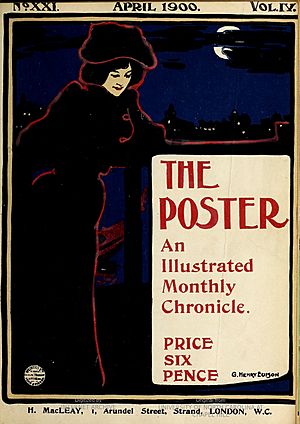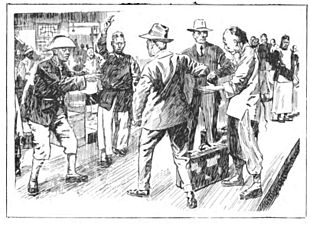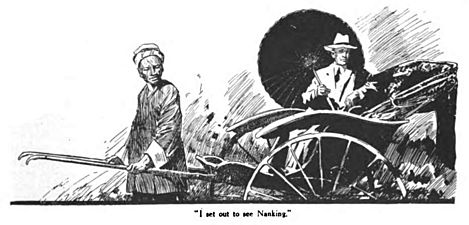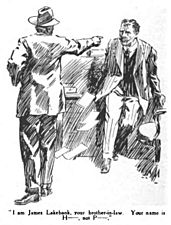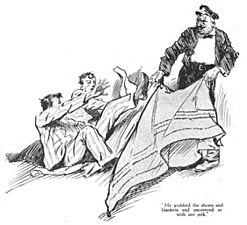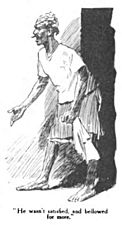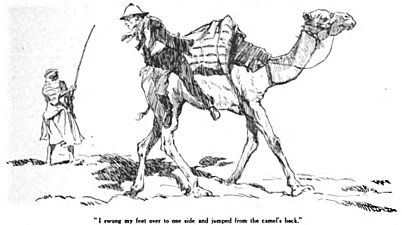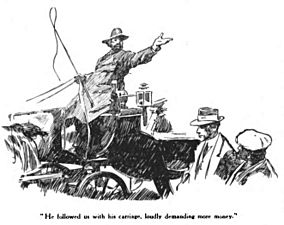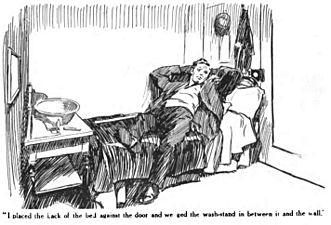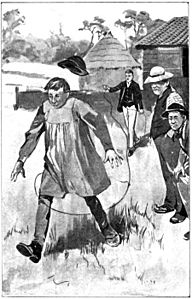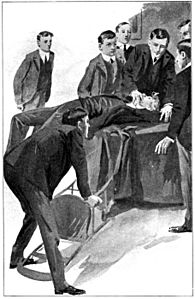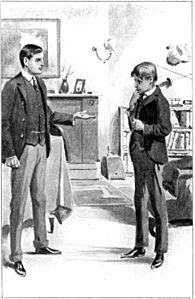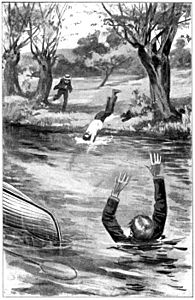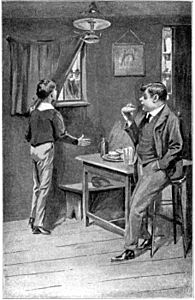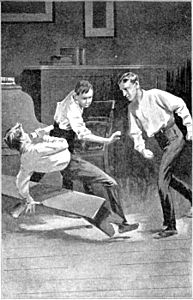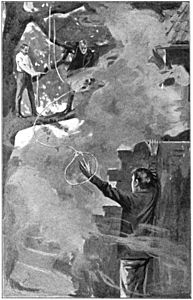G. H. Evison facts for kids
Quick facts for kids
George Henry Evison
|
|
|---|---|
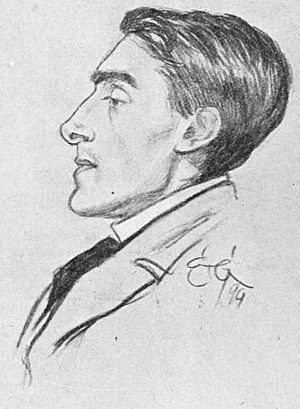
G H Evison in 1899
|
|
| Born | 25 November 1871 |
| Died | 1928 (aged 56–57) |
| Nationality | English |
| Other names | Signed as G . H. Evison or Henry Evison |
| Occupation | Artist and Book Illustrator |
| Years active | 1890 – 1925 |
| Known for | Illustrating the Daily Mail's Sixpenny Novels |
George Henry Evison (born November 25, 1871 – died 1928) was a talented artist and book illustrator from Liverpool, England. He was known for his strong line drawings in many books and magazines. He also created colorful wash drawings for magazines.
Contents
Early Life and Family
George Henry Evison was born on November 25, 1871, in Bootle, a town near Liverpool. He was the second child of William Flinn Evison and Sarah Ellen Emson. His father worked as a clerk in the shipping business.
Sadly, George's older sister, Lillie, died shortly after he was born. His father passed away the following year, before George's first birthday.
Becoming an Artist: Training and Studies
George Evison started his art career with an apprenticeship in Liverpool. He learned to be a lithographic artist, which means he learned how to create images on stone or metal plates for printing. At the same time, he took evening classes at the Liverpool School of Art. This school was the first art school built outside of London.
Around 1890, after his apprenticeship, George decided he preferred drawing with pen and ink over lithography. He then studied pen and ink drawing full-time at the Liverpool School of Art. He was very good and even won a scholarship worth £60, which was a lot of money back then!
His drawings started to be accepted by popular magazines like Pick-me-up and Judy. This success led him to move to London. There, he studied for a year at the famous Slade School of Fine Art. By 1900, he was well-known in London, even illustrating the cover of The Poster magazine.
Showing His Art: Exhibitions
George Evison displayed his artwork in several important galleries. He showed his pieces seven times at the Walker Art Gallery in Liverpool. He also exhibited four times at the Royal Academy in London.
Some of his works shown at the Walker Gallery were sold. For example, his painting Tea-Time sold for £10 in 1894.
Illustrating Magazines
Evison spent a lot of his time illustrating for magazines. He drew pictures for many different publications, including:
- Judy (a weekly comic magazine)
- English Illustrated Magazine
- The Idler
- The Poster
- The Wide World Magazine
- The Strand Magazine
- The Bystander
- To-day (where he illustrated two stories by Barry Pain)
By 1900, Evison had worked for many of the biggest publishers of the time, like George Newnes and Pearson's. These companies published a huge variety of magazines, some with hundreds of thousands of copies printed!
Magazine Illustration Example: Wide World Magazine
George Evison was a regular artist for George Newnes' Wide World Magazine. He created about two dozen illustrations for a story called From Job to Job Around the World. This story was about two young Americans who traveled the world with very little money.
Illustrating Books
George Evison started illustrating books a bit later in his career. He became very busy illustrating the Daily Mail's "sixpenny novels." These were cheap books that cost only sixpence, making them affordable for many people.
Evison's strong pen and ink drawings were perfect for these cheaper books. The paper used for these editions wasn't always the best, so bold, clear drawings reproduced well. He also illustrated full-priced books, sometimes using painted illustrations instead of just pen and ink.
Here are a few examples of books he illustrated:
| Author | Year | Title | Publisher |
|---|---|---|---|
| George MacDonald | 1893 | A Dish of Orts | Sampson Low and Company |
| Eric Lisle | 1907 | Under Honour's Flag | Frederick Warne & Co |
| Herbert Escott Inman | 1908 | The Mill-Lass of Idderleigh | Frederick Warne & Co |
| Stella. M. Düring | 1910 | Malicious Fortune | Amalgamated Press |
| William Le Queux | 1911 | Treasure of Israel | Amalgamated Press |
| Charles Dickens | 1920 | The Adventures of Oliver Twist | David McKay |
| T. C. Bridges | 1921 | The Sky Riders | George G. Harrap & Co. |
| Mona Tracy | 1927 | Rifle and Tomahawk | George G. Harrap |
Book Illustration Example: Under Honour's Flag
The illustrations below are from a more expensive book called Under Honour's Flag by Rev. Eric Lisle (1907). For this book, Evison used painted illustrations, not just his usual pen and ink style. The story is about a boy who overcomes challenges and becomes a hero.
Later Life and Death
George Evison passed away in 1928. He was buried on June 5, 1928, in Harrow, England. For many years, he had lived at his cousin's house in Pinner.
His Artistic Style
Experts say that George Evison was especially good at drawing people. He often used a mix of pen and ink with thick colors. His bold and clear drawings were very suitable for the types of books and magazines he illustrated, especially the cheaper ones. While his book illustrations were often limited by printing methods, his magazine work showed a wider range of his artistic talent.



